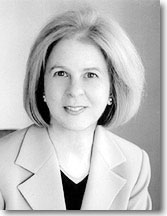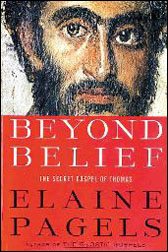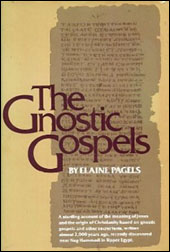 |
Elaine Pagels Religious Historian Dept. of Religion, Princeton University
Lecture: Revisioning Christianity:
Harry Camp Lectures and Seminars
Edited by Peter Y. Chou |
|
Preface: Cubberley Auditorium at Stanford School of Education was packed with many
standing in the aisles.
Prof. John Bender Director of Stanford Humanities Center gave a brief introduction
to the Harry Camp Lectures & Seminars. Then
Prof. Seth Lerer of Stanford's English & Comparative Literature Departments gave a humorous
introduction to Elaine Pagels— "More than anyone, Elaine Pagels has introduced us to early
Christianity. The virtue is not just in her book but in her life. When I was in my 20's, there
was no religion in my life. There were lots of human psychology to explore, but is it for me?
We learn from the praise of others. What could I have in common with Elaine Pagels? I taught
at Princeton but never met her there. I do have a book published by Princeton University Press
and Elaine Pagels is teaching at Princeton. I googled myself and found 881 web pages on Seth Lerer
and 31,000 web pages on Elaine Pagels. At Amazon. com, I was happy to find that 'customers who bought
titles by Seth Lerer also bought titles by Elaine Pagels'. While my book ranked 846,000 in sales
[Lerer,
Chaucer and His Readers (600,158) and Error and the Academic Self (838,567)],
Pagels' books are among the most popular in the top 100's [Gnostic Gospels (74),
Adam, Eve, and the Serpent (1324), Origin of Satan (628), Beyond Belief (305)].
Elaine Pagels' work shows original synthesis of the "Dead Sea Scrolls" and "Nag Hammadi" texts.
Her work grows out of personal tension of scholarship. She delves into the politics and piety in everyday
life. She examines the kind of Christianity that separates good & evil, the saved & damned, the intricate
relationship between early Christianity and Judaism. She tells me that she has a broken ankle, but I'm
sure her lecture will illumine us all." Prof. Lerer's self-deprecating humor brought lots of laughter
from the audience. Elaine Pagels then walked slowly onstage with her crutches, saying that she
has a broken ankle but it's healing. Then she put her crutches aside by the podium and launched into her
lecture. Waving her arms and gesturning for emphasis, she compared the Gospel of John with the
Gospel of Thomas. While Thomas tells that we are all children of God and can experience the
transcendent directly, John was emphatic that Jesus is "the only son of God" and only through Jesus
can we enter the Kingdom of Heaven. To discredit Thomas, John portrayed him as the "Doubting Thomas"
in his Gospel, and as the only one who was absent at Christ's resurrection. It was a real eye-opener that
Elaine Pagels compared the two texts side by side, bringing out the intense struggle of early Christianity.
I felt that Pagels was toppling the foundations of Christianity with her insightful discoveries.
After her lecture, I was walking with my friends to the parking lot when we chanced upon Prof.
Bender and Elaine Pagels in front of the Cubberley Building. I went up to Elaine and told her
how much I enjoyed her tour de force lecture. The Gospel of John was my favorite
among the Four Gospels and now I have to re-read it for its bias. Elaine told me to read
Chapter 4 of her Beyond Belief that shows why John was included in the canonical texts
and Thomas left out. The last time Elaine Pagels lectured at Stanford ("The Origin of Satan" 1996),
I was inspired to write a poem about the experience. Elaine told me that she would like to read it.
It took me a few days going through some 500 floppy disks before I found it—
"From Pagels to Pegasus". Meanwhile here are my notes of Elaine's lecture.
I wish to share with you this archaelogical discovery— looking for the Golden Age in graduate school— play Bible Land as my professor called it. My professor [Krister Stendhal] had lots of books on his shelf that I've never read. They were discovered in Nag Hammadi, Egypt, in 1945 in a sealed jar by a peasant. The scrolls were written originally in Greek, but found in Coptic, a language spoken in Egypt some 16 centuries ago. The Gnostic Gospels consists of these 50 ancient Christian writings, among them was The Gospel of Thomas. What do these texts mean? Athanasius, the Bishop of Alexandria, got rid of the secret Gnostic texts in 367 A.D. and saved 27 books which became the Nedw Testament. One of the monks buried the 50 texts. Irenaeus from rural Gaul declared that only four texts were genuine— Matthew, Luke, Mark, and John. They symbolized the 4 corners of the universe, the 4 winds, the 4 seasons. These were written by the disciples of Jesus. But so were the ones written in the Nag Hammadi scrolls. The Gospel of Thomas was published in 1959. The scholars dealt with heresy as a matter of choice in selecting the canonical texts. But the Church regarded heresy as false doctrines. Mark wrote 40 years after Jesus died. Luke and Matthew 50-60 years later, and John 70 years later. Irenaeus wrote five volumes Against the Heretics, defining heresy as dualism, nihilism, bizarre mythology, philosophy. Compare Thomas to Matthew and Luke— "Blessed are the poor in spirit" (Matthew) & "Blessed are your poor" (Thomas). My professor said the Thomas text dated 20 years after Jesus died. I say that's wishful thinking. I've started on the third line of research. What can this text tell about the early Christian movement? Compare Thomas with John or Luke. There was an intense contentious argument between the followers of Jesus. What is the good news about Jesus? The texts were challenging each other. John detested Thomas. John & Thomas had lots in common. They assumed you know the story of Jesus. Mark's version: Jesus was baptized by John. Thomas begins with "These are the secrets Jesus spoke to his intimate disciples". In John 13-18 before Jesus was crucified, he taught to his disciples alone. The language and diction are similar. They both interpret Jesus's teaching similarly. Mark says the kingdom of Heaven is coming (Ch. 9) and end of time catastrophe (Ch. 13). John & Thomas infer the kingdom is right now, the present reality is to be experienced now. Thomas 3: Kingdom of God is spiritual reality that transform those who perceive it. John & Thomas: look at the beginning. Thomas 18: "Blessed is the one who stands at the beginning." Refer to Genesis 1.3: "Let there be light and there was light." Not ordinary light, but divine energy. He is one who comes. Thomas 77: "I am the light that is over all things. I am all: from me all came forth." Ezekiel 1.14: "dazzling light, radiant diamond and sapphire" Genesis 1.26: "God made man in his own image." The image is divine energy that made the world came into being. Thomas: "You'll find it not only in Jesus, but in you!" We all came from the same source. We are all children of God. Thomas 50: "If they say to you, 'Where have you come from?' don't say Palo Alto, "say to them 'We have come from the light". Thomas 108: "Whoever drinks from the light comes from me." And this is my favorite— Thomas 70: "If you bring forth what is within you, what you have will save you. If you do not have that within you, what you do not have within you will destroy you." I thought this was psychological. John says "I am the light of the world." You and I are not. That's the bad news. John I: "In the beginning was the Word". That light was not available to anyone. John I.5: "The darkness never grasped the divine light" (actual Greek). There was divine light available, but only through when Jesus came. He was the only begotten Son of God. Not you and me. The world was lost in sin. John 3.16: "God loved the world that he gave his only begotten son." In Gospel of John, there is no "Sermon on the Mount". The "I am" saying— the door, water of life, the vine. Whatever you need— I am that. John 8.58: "Before Abraham was, I am." Jesus is God in person. That's why the Jews stoned him for blasphemy. John says Thomas finally got it when he cries out "My Lord, My God". John 8: Jesus speaks of difference. "I am above. You are below." John turns Thomas into a character, "Doubting Thomas" (nowhere in the other Gospels). John turns Thomas into a faithless disciple. John 11: Jesus raises Lazarus. John 14: I am going to the Father". Thomas: "We don't know the way." Jesus: "I am the Way, no one comes to the Father but through me." Read Luke & Matthew. Jesus came to 11 disciples (Thomas among them). John: Who represents Jesus after he is dead. John 21: "You are my apostles." He breathed among them the holy spirit. But Thomas missed the meeting. Only 10 of the disciples were there. Thomas had to touch Jesus's wound before he believed in his resurrection. John: only Jesus is divine. Thomas: the divine is within all of us. During the 2nd-4th century, Christians used John's language to reveal Christ's divinity. The Nicaen Creed used John's language. Irenaeus cites the Gospel of John and says that Jesus is the ontological God. (Lecture ended at 5:55 pm) Prof. Bender told the audience that there will be a two-hour Discussion Session of Pagels' lecture at Stanford's Humanities Center tomorrow from 4-6 pm. But Elaine was gracious to take some questions from the audience in case some couldn't make it to tomorrow's discussion. Q & A Session:
Q: What did Jesus appear to his disciples? [Thomas 13]
|
*************************************************************************************
|
Books by Elaine Pagels: (at Amazon.com)
Web Links to Elaine Pagels |
| Top of Page | Pagels Seminar | Politics & Religion | Stanford Lectures |
| Gospel of Thomas (Patterson & Meyer) | Gospel of Thomas Commentary |
| Nag Hammadi Library | Gnosis Archive | A-Z Portals | Home |
| © Peter Y. Chou, WisdomPortal.com P.O. Box 390707, Mountain View, CA 94039 email: peter@wisdomportal.com (2-1-2004) |
 |

